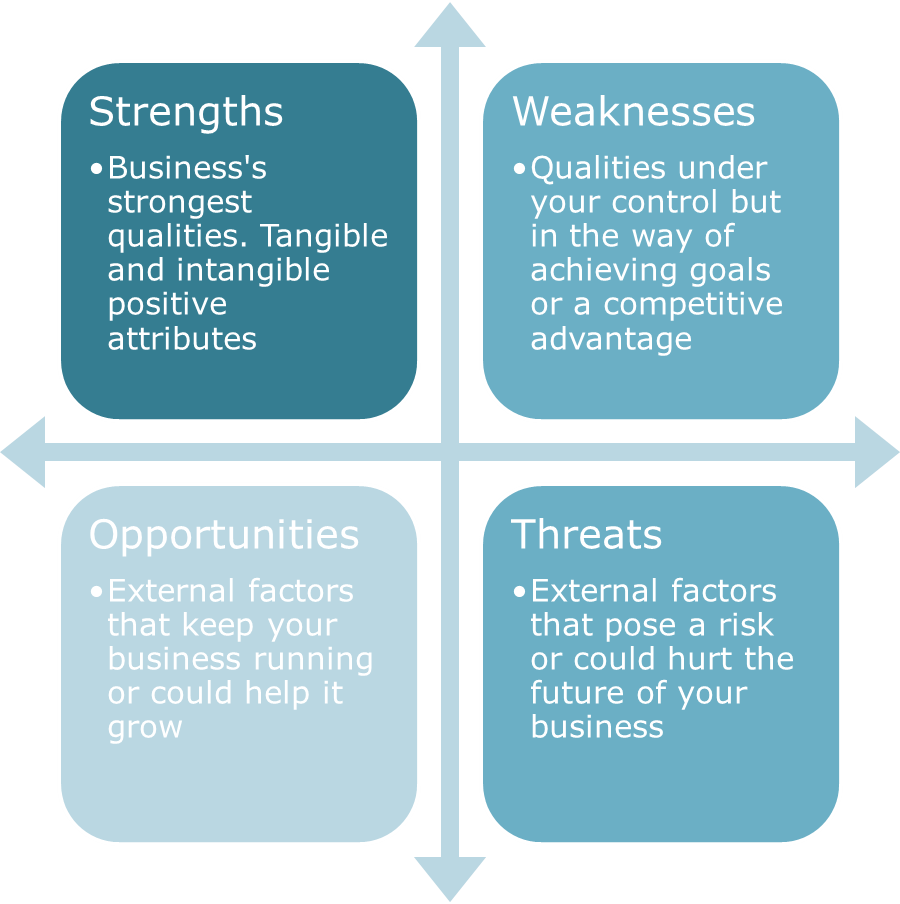Module 5: Assessing Your Practice Through SWOT Analysis
SWOT creates an analysis of your business in terms of four factors – Strengths, Weaknesses, Opportunities, and Threats.
Understanding the SWOT Analysis Process
A SWOT analysis is a 2 x 2 matrix. Strengths are listed in the upper left quadrant. Weaknesses are in the top right. Opportunities are listed in the bottom left and Threats are in the bottom right.
The left-hand column has factors that are helpful in reaching your business goals (Strengths and Opportunities). The right-hand lists factors that are potentially harmful (Weaknesses and Threats).
The top two quadrants include internal factors (Strengths and Weaknesses) and the bottom two quadrants include external factors (Opportunities and Threats).
Identifying Your Practice's Strengths
Examples of Strengths include:
- Keen understanding of niche / Special research resources
- Highly recognizable brand with strong following
- Staff who are committed to the company’s vision
- Low production cost for products
- High traffic location
- Good distribution network in place
- Years of experience
- Reputation for innovation
- Fast and efficient product development processes
Identifying Your Practice's Weaknesses
Try to make an honest assessment and don’t let pride get in your way. Identifying these areas of weakness is the first step in improving them.
Weaknesses include things such as:
- Lack of relevant experience
- Limited resources
- Lack of access to new technology
- Current production or distribution methods are costly
- Small workforce or staff resources already stretched
- Gaps in capabilities
- High operating costs
- Lack of partners or outside help
- Poor leadership or morale within the company
- Disorganization or record-keeping problems
Identifying Your Practice's Opportunities
Examples of opportunities include:
- Market trends that are in your company’s favor
- Changes in society that could make your offer more attractive
- New emerging technologies
- Growth in key segments of the market
- Vulnerabilities of competitors which give you a chance to shine
- Similar products on the market have clear disadvantages to yours
- Your products or services may improve local economy, community, or environment
- Potential partnerships that could prove lucrative
- Rising or changing customer demand for your product
- Product or campaign’s potential to boost your company’s image
- Seasonal influences
- New marketing channels you can use to reach your audience
Identifying Threats to Your Practice
Although negative, Threats should excite you as well because they indicate a clear direction to go. They show you how you can immediately improve your circumstances and gain an advantage.
Threats can include:
- Activities of your competitors such as increased sales or exposure
- Unstable prices in the current market
- New regulations that affect your products
- General economic downturn
- Changes in customer tastes or behavior
- Bad press for your industry
- Political instability or world events that could affect your business
- Environmental problems
- Similar products that are popular
- Time delays due to outside factors
- New technologies that could negatively impact your sales
- Bad employment market
- Competitors moving in on your space or your market
It’s difficult to see these Threats as anything but bad, but try to think of them as challenges. If you consider them this way, each Threat can guide you in a new and more lucrative direction.
For both Opportunities and Threats, you’re looking for potentialities. These are not necessarily things that are happening now nor things predicted to happen, but they’re possible in the future.
Action Steps
Todd McCall
I help practices who are marketing professional services get the attention they deserve by developing an online presence that converts visitors into clients.


